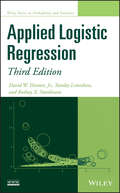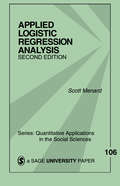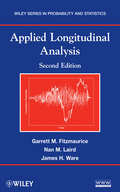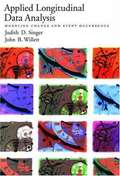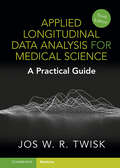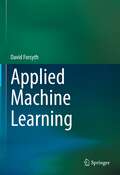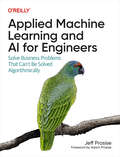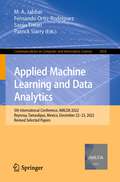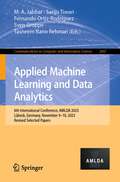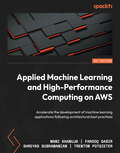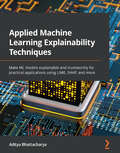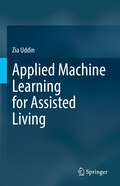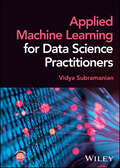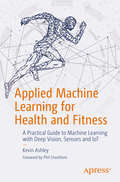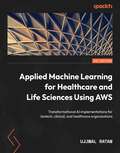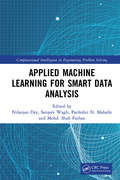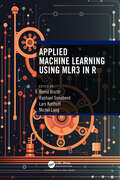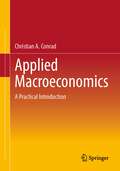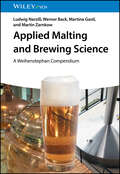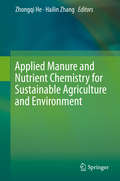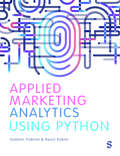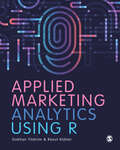- Table View
- List View
Applied Logistic Regression (Wiley Series in Probability and Statistics #398)
by Stanley Lemeshow David W. Hosmer Jr. Rodney X. SturdivantA new edition of the definitive guide to logistic regression modeling for health science and other applicationsThis thoroughly expanded Third Edition provides an easily accessible introduction to the logistic regression (LR) model and highlights the power of this model by examining the relationship between a dichotomous outcome and a set of covariables.Applied Logistic Regression, Third Edition emphasizes applications in the health sciences and handpicks topics that best suit the use of modern statistical software. The book provides readers with state-of-the-art techniques for building, interpreting, and assessing the performance of LR models. New and updated features include:A chapter on the analysis of correlated outcome dataA wealth of additional material for topics ranging from Bayesian methods to assessing model fitRich data sets from real-world studies that demonstrate each method under discussionDetailed examples and interpretation of the presented results as well as exercises throughoutApplied Logistic Regression, Third Edition is a must-have guide for professionals and researchers who need to model nominal or ordinal scaled outcome variables in public health, medicine, and the social sciences as well as a wide range of other fields and disciplines.
Applied Logistic Regression Analysis (Quantitative Applications in the Social Sciences #106)
by Dr Scott MenardThe focus in this Second Edition is again on logistic regression models for individual level data, but aggregate or grouped data are also considered. The book includes detailed discussions of goodness of fit, indices of predictive efficiency, and standardized logistic regression coefficients, and examples using SAS and SPSS are included. More detailed consideration of grouped as opposed to case-wise data throughout the book Updated discussion of the properties and appropriate use of goodness of fit measures, R-square analogues, and indices of predictive efficiency Discussion of the misuse of odds ratios to represent risk ratios, and of over-dispersion and under-dispersion for grouped data Updated coverage of unordered and ordered polytomous logistic regression models.
Applied Longitudinal Analysis
by Garrett M. Fitzmaurice James H. Ware Nan M. LairdFeatures newly developed topics and applications of the analysis of longitudinal data. Applied Longitudinal Analysis, Second Edition presents modern methods for analyzing data from longitudinal studies and now features the latest state-of-the-art techniques. The book emphasizes practical, rather than theoretical, aspects of methods for the analysis of diverse types of longitudinal data that can be applied across various fields of study, from the health and medical sciences to the social and behavioral sciences.The authors incorporate their extensive academic and research experience along with various updates that have been made in response to reader feedback. The Second Edition features six newly added chapters that explore topics currently evolving in the field, including:Fixed effects and mixed effects models. Marginal models and generalized estimating equations. Approximate methods for generalized linear mixed effects models. Multiple imputation and inverse probability weighted methods. Smoothing methods for longitudinal data. Sample size and power. Each chapter presents methods in the setting of applications to data sets drawn from the health sciences. New problem sets have been added to many chapters, and a related website features sample programs and computer output using SAS, Stata, and R, as well as data sets and supplemental slides to facilitate a complete understanding of the material.With its strong emphasis on multidisciplinary applications and the interpretation of results, Applied Longitudinal Analysis, Second Edition is an excellent book for courses on statistics in the health and medical sciences at the upper-undergraduate and graduate levels. The book also serves as a valuable reference for researchers and professionals in the medical, public health, and pharmaceutical fields as well as those in social and behavioral sciences who would like to learn more about analyzing longitudinal data.
Applied Longitudinal Data Analysis: Modeling Change and Event Occurrence
by Judith D. Singer John B. WillettChange is constant in everyday life. Infants crawl and then walk, children learn to read and write, teenagers mature in myriad ways, the elderly become frail and forgetful. Beyond these natural processes and events, external forces and interventions instigate and disrupt change: test scores may rise after a coaching course, drug abusers may remain abstinent after residential treatment. By charting changes over time and investigating whether and when events occur, researchers reveal the temporal rhythms of our lives. Applied Longitudinal Data Analysis is a much-needed professional book for empirical researchers and graduate students in the behavioral, social, and biomedical sciences. It offers the first accessible in-depth presentation of two of today's most popular statistical methods: multilevel models for individual change and hazard/survival models for event occurrence (in both discrete- and continuous-time). Using clear, concise prose and real data sets from published studies, the authors take you step by step through complete analyses, from simple exploratory displays that reveal underlying patterns through sophisticated specifications of complex statistical models. Applied Longitudinal Data Analysis offers readers a private consultation session with internationally recognized experts and represents a unique contribution to the literature on quantitative empirical methods.
Applied Longitudinal Data Analysis for Epidemiology
by Jos W. R. TwiskThis book discusses the most important techniques available for longitudinal data analysis, from simple techniques such as the paired t-test and summary statistics, to more sophisticated ones such as generalized estimating of equations and mixed model analysis. A distinction is made between longitudinal analysis with continuous, dichotomous and categorical outcome variables. The emphasis of the discussion lies in the interpretation and comparison of the results of the different techniques. The second edition includes new chapters on the role of the time variable and presents new features of longitudinal data analysis. Explanations have been clarified where necessary and several chapters have been completely rewritten. The analysis of data from experimental studies and the problem of missing data in longitudinal studies are discussed. Finally, an extensive overview and comparison of different software packages is provided. This practical guide is essential for non- statisticians and researchers working with longitudinal data from epidemiological and clinical studies.
Applied Longitudinal Data Analysis for Medical Science: A Practical Guide
by Jos W. TwiskEssential for non-statisticians and researchers working with longitudinal data from medical studies, this updated new edition discusses the most important techniques available for analysing data of this type. Using non-technical language, the book explores simple methods such as the paired t-test and summary statistics as well as more sophisticated regression-based methods, including mixed model analysis. The emphasis of the discussion lies in the interpretation of the results of these different methods, covering data analysis with continuous, dichotomous, categorical and other outcome variables. Datasets used throughout the book are provided, enabling readers to re-analyse the examples as they make their way through chapters and improve their understanding of the material. Finally, an extensive and practical overview of, and comparison between, different software packages is provided. Readers will be able to use this book as a practical manual in their everyday work without needing a strong background in statistics.
Applied Machine Learning
by David ForsythMachine learning methods are now an important tool for scientists, researchers, engineers and students in a wide range of areas. This book is written for people who want to adopt and use the main tools of machine learning, but aren’t necessarily going to want to be machine learning researchers. Intended for students in final year undergraduate or first year graduate computer science programs in machine learning, this textbook is a machine learning toolkit. Applied Machine Learning covers many topics for people who want to use machine learning processes to get things done, with a strong emphasis on using existing tools and packages, rather than writing one’s own code.A companion to the author's Probability and Statistics for Computer Science, this book picks up where the earlier book left off (but also supplies a summary of probability that the reader can use).Emphasizing the usefulness of standard machinery from applied statistics, this textbook gives an overview of the major applied areas in learning, including coverage of:• classification using standard machinery (naive bayes; nearest neighbor; SVM)• clustering and vector quantization (largely as in PSCS)• PCA (largely as in PSCS)• variants of PCA (NIPALS; latent semantic analysis; canonical correlation analysis)• linear regression (largely as in PSCS)• generalized linear models including logistic regression• model selection with Lasso, elasticnet• robustness and m-estimators• Markov chains and HMM’s (largely as in PSCS)• EM in fairly gory detail; long experience teaching this suggests one detailed example is required, which students hate; but once they’ve been through that, the next one is easy• simple graphical models (in the variational inference section)• classification with neural networks, with a particular emphasis onimage classification• autoencoding with neural networks• structure learning
Applied Machine Learning and AI for Engineers: Solve Business Problems That Can't Be Solved Algorithmically
by Jeff ProsiseWhile many introductory guides to AI are calculus books in disguise, this one mostly eschews the math. Instead, author Jeff Prosise helps engineers and software developers build an intuitive understanding of AI to solve business problems. Need to create a system to detect the sounds of illegal logging in the rainforest, analyze text for sentiment, or predict early failures in rotating machinery? This practical book teaches you the skills necessary to put AI and machine learning to work at your company. Applied Machine Learning and AI for Engineers provides examples and illustrations from the AI and ML course Prosise teaches at companies and research institutions worldwide. There's no fluff and no scary equations—just a fast start for engineers and software developers, complete with hands-on examples. This book helps you: Learn what machine learning and deep learning are and what they can accomplishUnderstand how popular learning algorithms work and when to apply themBuild machine learning models in Python with Scikit-Learn, and neural networks with Keras and TensorFlowTrain and score regression models and binary and multiclass classification modelsBuild facial recognition models and object detection modelsBuild language models that respond to natural-language queries and translate text to other languagesUse Cognitive Services to infuse AI into the apps that you write
Applied Machine Learning and Data Analytics: 5th International Conference, AMLDA 2022, Reynosa, Tamaulipas, Mexico, December 22–23, 2022, Revised Selected Papers (Communications in Computer and Information Science #1818)
by M. A. Jabbar Fernando Ortiz-Rodríguez Sanju Tiwari Patrick SiarryThis book constitutes the refereed proceedings of the 5th International Conference on Applied Machine Learning and Data Analytics, AMLDA 2022, held in Reynosa, Tamaulipas, Mexico, during December 22–23, 2022. The 16 full papers and 4 short papers included in this book were carefully reviewed and selected from 89 submissions. They were organized in topical sections as follows: Machine learning, Healthcare and medical imaging informatics; biometrics; forensics; precision agriculture; risk management; robotics and satellite imaging.
Applied Machine Learning and Data Analytics: 6th International Conference, AMLDA 2023, Lübeck, Germany, November 9–10, 2023, Revised Selected Papers (Communications in Computer and Information Science #2047)
by M. A. Jabbar Sanju Tiwari Fernando Ortiz-Rodríguez Sven Groppe Tasneem Bano RehmanThis book constitutes the refereed conference proceedings of the 6th International Conference on Applied Machine Learning and Data Analytics, AMLDA 2023, held in Lübeck, Germany, during November 9–10, 2023.The 17 full papers and 2 short papers presented in this book were carefully reviewed and selected from 76 submissions. The main conference AMLDA 2023 is renowned for presenting cutting-edge research on all aspects of machine learning as well as important application areas such as healthcare and medical imaging informatics, biometrics, forensics, precision agriculture, risk management, robotics, and satellite imaging.
Applied Machine Learning and High-Performance Computing on AWS: Accelerate the development of machine learning applications following architectural best practices
by Shreyas Subramanian Trenton Potgieter Mani Khanuja Farooq SabirBuild, train, and deploy large machine learning models at scale in various domains such as computational fluid dynamics, genomics, autonomous vehicles, and numerical optimization using Amazon SageMakerKey FeaturesUnderstand the need for high-performance computing (HPC)Build, train, and deploy large ML models with billions of parameters using Amazon SageMakerLearn best practices and architectures for implementing ML at scale using HPCBook DescriptionMachine learning (ML) and high-performance computing (HPC) on AWS run compute-intensive workloads across industries and emerging applications. Its use cases can be linked to various verticals, such as computational fluid dynamics (CFD), genomics, and autonomous vehicles.This book provides end-to-end guidance, starting with HPC concepts for storage and networking. It then progresses to working examples on how to process large datasets using SageMaker Studio and EMR. Next, you'll learn how to build, train, and deploy large models using distributed training. Later chapters also guide you through deploying models to edge devices using SageMaker and IoT Greengrass, and performance optimization of ML models, for low latency use cases.By the end of this book, you'll be able to build, train, and deploy your own large-scale ML application, using HPC on AWS, following industry best practices and addressing the key pain points encountered in the application life cycle.What you will learnExplore data management, storage, and fast networking for HPC applicationsFocus on the analysis and visualization of a large volume of data using SparkTrain visual transformer models using SageMaker distributed trainingDeploy and manage ML models at scale on the cloud and at the edgeGet to grips with performance optimization of ML models for low latency workloadsApply HPC to industry domains such as CFD, genomics, AV, and optimizationWho this book is forThe book begins with HPC concepts, however, it expects you to have prior machine learning knowledge. This book is for ML engineers and data scientists interested in learning advanced topics on using large datasets for training large models using distributed training concepts on AWS, deploying models at scale, and performance optimization for low latency use cases. Practitioners in fields such as numerical optimization, computation fluid dynamics, autonomous vehicles, and genomics, who require HPC for applying ML models to applications at scale will also find the book useful.
Applied Machine Learning Explainability Techniques: Make ML models explainable and trustworthy for practical applications using LIME, SHAP, and more
by Aditya BhattacharyaLeverage top XAI frameworks to explain your machine learning models with ease and discover best practices and guidelines to build scalable explainable ML systemsKey FeaturesExplore various explainability methods for designing robust and scalable explainable ML systemsUse XAI frameworks such as LIME and SHAP to make ML models explainable to solve practical problemsDesign user-centric explainable ML systems using guidelines provided for industrial applicationsBook DescriptionExplainable AI (XAI) is an emerging field that brings artificial intelligence (AI) closer to non-technical end users. XAI makes machine learning (ML) models transparent and trustworthy along with promoting AI adoption for industrial and research use cases.Applied Machine Learning Explainability Techniques comes with a unique blend of industrial and academic research perspectives to help you acquire practical XAI skills. You'll begin by gaining a conceptual understanding of XAI and why it's so important in AI. Next, you'll get the practical experience needed to utilize XAI in AI/ML problem-solving processes using state-of-the-art methods and frameworks. Finally, you'll get the essential guidelines needed to take your XAI journey to the next level and bridge the existing gaps between AI and end users.By the end of this ML book, you'll be equipped with best practices in the AI/ML life cycle and will be able to implement XAI methods and approaches using Python to solve industrial problems, successfully addressing key pain points encountered.What you will learnExplore various explanation methods and their evaluation criteriaLearn model explanation methods for structured and unstructured dataApply data-centric XAI for practical problem-solvingHands-on exposure to LIME, SHAP, TCAV, DALEX, ALIBI, DiCE, and othersDiscover industrial best practices for explainable ML systemsUse user-centric XAI to bring AI closer to non-technical end usersAddress open challenges in XAI using the recommended guidelinesWho this book is forThis book is for scientists, researchers, engineers, architects, and managers who are actively engaged in machine learning and related fields. Anyone who is interested in problem-solving using AI will benefit from this book. Foundational knowledge of Python, ML, DL, and data science is recommended. AI/ML experts working with data science, ML, DL, and AI will be able to put their knowledge to work with this practical guide. This book is ideal for you if you're a data and AI scientist, AI/ML engineer, AI/ML product manager, AI product owner, AI/ML researcher, and UX and HCI researcher.
Applied Machine Learning for Assisted Living
by Zia UddinUser care at home is a matter of great concern since unforeseen circumstances might occur that affect people's well-being. Technologies that assist people in independent living are essential for enhancing care in a cost-effective and reliable manner. Assisted care applications often demand real-time observation of the environment and the resident’s activities using an event-driven system. As an emerging area of research and development, it is necessary to explore the approaches of the user care system in the literature to identify current practices for future research directions. Therefore, this book is aimed at a comprehensive review of data sources (e.g., sensors) with machine learning for various smart user care systems. To encourage the readers in the field, insights of practical essence of different machine learning algorithms with sensor data (e.g., publicly available datasets) are also discussed. Some code segments are also included to motivate the researchers of the related fields to practically implement the features and machine learning techniques. It is an effort to obtain knowledge of different types of sensor-based user monitoring technologies in-home environments. With the aim of adopting these technologies, research works, and their outcomes are reported. Besides, up to date references are included for the user monitoring technologies with the aim of facilitating independent living.Research that is related to the use of user monitoring technologies in assisted living is very widespread, but it is still consists mostly of limited-scale studies. Hence, user monitoring technology is a very promising field, especially for long-term care. However, monitoring of the users for smart assisted technologies should be taken to the next level with more detailed studies that evaluate and demonstrate their potential to contribute to prolonging the independent living of people. The target of this book is to contribute towards that direction.
Applied Machine Learning for Data Science Practitioners
by Vidya SubramanianA single-volume reference on data science techniques for evaluating and solving business problems using Applied Machine Learning (ML). Applied Machine Learning for Data Science Practitioners offers a practical, step-by-step guide to building end-to-end ML solutions for real-world business challenges, empowering data science practitioners to make informed decisions and select the right techniques for any use case. Unlike many data science books that focus on popular algorithms and coding, this book takes a holistic approach. It equips you with the knowledge to evaluate a range of techniques and algorithms. The book balances theoretical concepts with practical examples to illustrate key concepts, derive insights, and demonstrate applications. In addition to code snippets and reviewing output, the book provides guidance on interpreting results. This book is an essential resource if you are looking to elevate your understanding of ML and your technical capabilities, combining theoretical and practical coding examples. A basic understanding of using data to solve business problems, high school-level math and statistics, and basic Python coding skills are assumed. Written by a recognized data science expert, Applied Machine Learning for Data Science Practitioners covers essential topics, including: Data Science Fundamentals that provide you with an overview of core concepts, laying the foundation for understanding ML. Data Preparation covers the process of framing ML problems and preparing data and features for modeling. ML Problem Solving introduces you to a range of ML algorithms, including Regression, Classification, Ranking, Clustering, Patterns, Time Series, and Anomaly Detection. Model Optimization explores frameworks, decision trees, and ensemble methods to enhance performance and guide the selection of the most effective model. ML Ethics addresses ethical considerations, including fairness, accountability, transparency, and ethics. Model Deployment and Monitoring focuses on production deployment, performance monitoring, and adapting to model drift.
Applied Machine Learning for Health and Fitness: A Practical Guide to Machine Learning with Deep Vision, Sensors and IoT
by Kevin AshleyExplore the world of using machine learning methods with deep computer vision, sensors and data in sports, health and fitness and other industries. Accompanied by practical step-by-step Python code samples and Jupyter notebooks, this comprehensive guide acts as a reference for a data scientist, machine learning practitioner or anyone interested in AI applications. These ML models and methods can be used to create solutions for AI enhanced coaching, judging, athletic performance improvement, movement analysis, simulations, in motion capture, gaming, cinema production and more.Packed with fun, practical applications for sports, machine learning models used in the book include supervised, unsupervised and cutting-edge reinforcement learning methods and models with popular tools like PyTorch, Tensorflow, Keras, OpenAI Gym and OpenCV. Author Kevin Ashley—who happens to be both a machine learning expert and a professional ski instructor—has written an insightful book that takes you on a journey of modern sport science and AI. Filled with thorough, engaging illustrations and dozens of real-life examples, this book is your next step to understanding the implementation of AI within the sports world and beyond. Whether you are a data scientist, a coach, an athlete, or simply a personal fitness enthusiast excited about connecting your findings with AI methods, the author’s practical expertise in both tech and sports is an undeniable asset for your learning process. Today’s data scientists are the future of athletics, and Applied Machine Learning for Health and Fitness hands you the knowledge you need to stay relevant in this rapidly growing space.What You'll LearnUse multiple data science tools and frameworksApply deep computer vision and other machine learning methods for classification, semantic segmentation, and action recognitionBuild and train neural networks, reinforcement learning models and moreAnalyze multiple sporting activities with deep learningUse datasets available today for model trainingUse machine learning in the cloud to train and deploy modelsApply best practices in machine learning and data scienceWho This Book Is ForPrimarily aimed at data scientists, coaches, sports enthusiasts and athletes interested in connecting sports with technology and AI methods.
Applied Machine Learning for Healthcare and Life Sciences Using AWS: Transformational AI implementations for biotech, clinical, and healthcare organizations
by Ujjwal RatanBuild real-world artificial intelligence apps on AWS to overcome challenges faced by healthcare providers and payers, as well as pharmaceutical, life sciences research, and commercial organizationsKey FeaturesLearn about healthcare industry challenges and how machine learning can solve themExplore AWS machine learning services and their applications in healthcare and life sciencesDiscover practical coding instructions to implement machine learning for healthcare and life sciencesBook DescriptionWhile machine learning is not new, it's only now that we are beginning to uncover its true potential in the healthcare and life sciences industry. The availability of real-world datasets and access to better compute resources have helped researchers invent applications that utilize known AI techniques in every segment of this industry, such as providers, payers, drug discovery, and genomics. This book starts by summarizing the introductory concepts of machine learning and AWS machine learning services. You'll then go through chapters dedicated to each segment of the healthcare and life sciences industry. Each of these chapters has three key purposes -- First, to introduce each segment of the industry, its challenges, and the applications of machine learning relevant to that segment. Second, to help you get to grips with the features of the services available in the AWS machine learning stack like Amazon SageMaker and Amazon Comprehend Medical. Third, to enable you to apply your new skills to create an ML-driven solution to solve problems particular to that segment. The concluding chapters outline future industry trends and applications. By the end of this book, you'll be aware of key challenges faced in applying AI to healthcare and life sciences industry and learn how to address those challenges with confidence.What you will learnExplore the healthcare and life sciences industryFind out about the key applications of AI in different industry segmentsApply AI to medical images, clinical notes, and patient dataDiscover security, privacy, fairness, and explainability best practicesExplore the AWS ML stack and key AI services for the industryDevelop practical ML skills using code and AWS servicesDiscover all about industry regulatory requirementsWho this book is forThis book is specifically tailored toward technology decision-makers, data scientists, machine learning engineers, and anyone who works in the data engineering role in healthcare and life sciences organizations. Whether you want to apply machine learning to overcome common challenges in the healthcare and life science industry or are looking to understand the broader industry AI trends and landscape, this book is for you. This book is filled with hands-on examples for you to try as you learn about new AWS AI concepts.
Applied Machine Learning for Smart Data Analysis (Computational Intelligence in Engineering Problem Solving)
by Nilanjan Dey Sanjeev Wagh Parikshit Mahalle Mohd. PathanThe book focusses on how machine learning and Internet of Things (IoT) has empowered the advancement of information driven arrangements including key concepts and advancements. Divided into sections such as machine learning, security, IoT and data mining, the concepts are explained with practical implementation including results.
Applied Machine Learning Using mlr3 in R
by Bernd Bischl Raphael Sonabend Lars Kotthoff Michel Langmlr3 is an award-winning ecosystem of R packages that have been developed to enable state-of-the-art machine learning capabilities in R. Applied Machine Learning Using mlr3 in R gives an overview of flexible and robust machine learning methods, with an emphasis on how to implement them using mlr3 in R. It covers various key topics, including basic machine learning tasks, such as building and evaluating a predictive model; hyperparameter tuning of machine learning approaches to obtain peak performance; building machine learning pipelines that perform complex operations such as pre-processing followed by modelling followed by aggregation of predictions; and extending the mlr3 ecosystem with custom learners, measures, or pipeline components. Features: In-depth coverage of the mlr3 ecosystem for users and developers Explanation and illustration of basic and advanced machine learning concepts Ready to use code samples that can be adapted by the user for their application Convenient and expressive machine learning pipelining enabling advanced modelling Coverage of topics that are often ignored in other machine learning books The book is primarily aimed at researchers, practitioners, and graduate students who use machine learning or who are interested in using it. It can be used as a textbook for an introductory or advanced machine learning class that uses R, as a reference for people who work with machine learning methods, and in industry for exploratory experiments in machine learning.
Applied Macroeconomics: A Practical Introduction
by Christian A. ConradThis textbook provides a comprehensive overview of macroeconomic relationships and explains the most important macroeconomic variables in an easy-to-understand manner. The reader is introduced to important macroeconomic variables such as inflation and aggregate demand in chapters that build on one another. They learn, among other things, how economic crises arise or the role and functioning of money, capital and goods markets. The aim is to provide the reader with economic knowledge that can be applied in business practice. The economics material has been deliberately selected so that business studies content is usefully supplemented. However, detailed explanations and both application-oriented and practice-related examples and exercises make it easy for non-economists to understand the complex economic topics. Well-founded knowledge presented in an immediately comprehensible way!
Applied Magic
by Dion FortunePractical applications of occultism, the group mind, the psychology of ritual, the circuit of force, 3 kinds of reality, non-humans, black magic, including an esoteric glossary
Applied Malting and Brewing Science: A Weihenstephan Compendium
by Ludwig Narziß Werner Back Martina Gastl Martin ZarnkowApplied Malting and Brewing Science The landmark guide to malting and brewing science is available in English for the first time Humans have been producing fermented beverages for at least ten thousand years. Chief among them is beer, which has arguably never been more popular than it is at this point in history. The United States alone boasts more than 9,500 breweries, a number which has risen steadily as the market for craft beer continues to grow in that country. Thus, maltsters and brewers there and around the world are constantly looking for ways to hone their skills to create products of the highest quality as consistently as possible. With the detailed information presented in this book, they will not only be able to reacquaint themselves with the basic tenets of their profession but will also acquire an in-depth scientific foundation and a wide range of practical knowledge in all aspects of advanced malting and brewing. This landmark work on malting and brewing, originally entitled Abriss der Bierbrauerei, is currently in its eighth edition and has hitherto only been offered in the German language. However, it is now finally available for the first time in translation, as an unabridged and updated English edition. Applied Malting and Brewing Science is a reference for those interested in any facet of malt and beer production, including all of the most recent technical innovations in equipment and processes. This book represents the collective knowledge amassed over many decades of research by Ludwig Narziß in his tenure as Professor at the Chair for Brewing Technology at Weihenstephan. Readers of Applied Malting and Brewing Science will find the following: Comprehensive treatment of topics covering raw materials, malt and wort production, fermentation, packaging and much more A team of authors with decades of experience in the fields of malting and brewing science, both in academia and in their application in the industry A design which facilitates use of the book as both a student textbook and as a practical guide Written by the late Ludwig Narziß and his team, Applied Malting and Brewing Science is an indispensable source for students at any level in related scientific disciplines and for anyone working in the malting and brewing industry.
Applied Manure and Nutrient Chemistry for Sustainable Agriculture and Environment
by Zhongqi He Hailin ZhangDue to the rapid increase in world population and improving living standards, the global agriculture sector is confronting with challenges for the sustainability of agricultural production and of the environment. Intensive high-yield agriculture is typically dependent on addition of fertilizers (synthetic chemicals, animal manure, etc. ). However, non-point nutrient losses from agricultural fields due to fertilization could adversely impact the environment. Increased knowledge on plant nutrient chemistry is required for improving utilization efficiency and minimizing loses from both inorganic and organic nutrient sources. For this purpose, the book is composed of 19 chapters that highlight recent research activities in applied nutrient chemistry geared toward sustainable agriculture and environment. Topics of interest include, but are not limited, to speciation, quantification, and interactions of various plant nutrients and relevant contributories in manure, soil, and plants. This book outlooks emerging researchable issues on alternative utilization and environmental monitoring of manure and other agricultural by products that may stimulate new research ideas and direction in the relevant fields.
Applied Marketing Analytics Using Python
by null Gokhan Yildirim null Raoul V. KüblerIt is vital for marketers today to be comfortable in their use of data and quantitative approaches and have a thorough grounding in understanding and using marketing analytics in order to gain insights, support strategic decision-making, solve marketing problems, maximise value and achieve success. Taking a very hands-on approach with the use of real-world datasets, case studies and Python, this book supports students and practitioners to explore a range of marketing phenomena using various applied analytics tools, with a balanced mix of technical coverage alongside marketing theory and frameworks. Supporting online resources include datasets and software codes and solutions as well as PowerPoint slides, a teaching guide and a testbank. This book is essential reading for advanced level marketing students and practitioners who want to become cutting-edge marketers. Dr Gokhan Yildirim is an Associate Professor of Marketing at Imperial College Business School, London. Dr Raoul V. Kübler is an Associate Professor of Marketing at ESSEC Business School, Paris.
Applied Marketing Analytics Using R
by Gokhan Yildirim Raoul V. KüblerMarketing has become increasingly data-driven in recent years as a result of new emerging technologies such as AI, granular data availability and ever-growing analytics tools. With this trend only set to continue, it’s vital for marketers today to be comfortable in their use of data and quantitative approaches and have a thorough grounding in understanding and using marketing analytics in order to gain insights, support strategic decision-making, solve marketing problems, maximise value and achieve success. Taking a very hands-on approach with the use of real-world datasets, case studies and R (a free statistical package), this book supports students and practitioners to explore a range of marketing phenomena using various applied analytics tools, with a balanced mix of technical coverage alongside marketing theory and frameworks. Chapters include learning objectives, figures, tables and questions to help facilitate learning. Also included online with the datasets are software codes and solutions (R Markdowns, HTML files) to use with the book, as well as PowerPoint slides, a teaching guide and a testbank for instructors teaching a marketing analytics course. This book is essential reading for advanced level marketing students and marketing practitioners who want to become cutting-edge marketers. Dr. Gokhan Yildirim is an Associate Professor of Marketing at Imperial College Business School, London. Dr. Raoul V. Kübler is an Associate Professor of Marketing at ESSEC Business School, Paris.
Applied Marketing Analytics Using R
by Gokhan Yildirim Raoul V. KüblerMarketing has become increasingly data-driven in recent years as a result of new emerging technologies such as AI, granular data availability and ever-growing analytics tools. With this trend only set to continue, it’s vital for marketers today to be comfortable in their use of data and quantitative approaches and have a thorough grounding in understanding and using marketing analytics in order to gain insights, support strategic decision-making, solve marketing problems, maximise value and achieve success. Taking a very hands-on approach with the use of real-world datasets, case studies and R (a free statistical package), this book supports students and practitioners to explore a range of marketing phenomena using various applied analytics tools, with a balanced mix of technical coverage alongside marketing theory and frameworks. Chapters include learning objectives, figures, tables and questions to help facilitate learning. Also included online with the datasets are software codes and solutions (R Markdowns, HTML files) to use with the book, as well as PowerPoint slides, a teaching guide and a testbank for instructors teaching a marketing analytics course. This book is essential reading for advanced level marketing students and marketing practitioners who want to become cutting-edge marketers. Dr. Gokhan Yildirim is an Associate Professor of Marketing at Imperial College Business School, London. Dr. Raoul V. Kübler is an Associate Professor of Marketing at ESSEC Business School, Paris.
